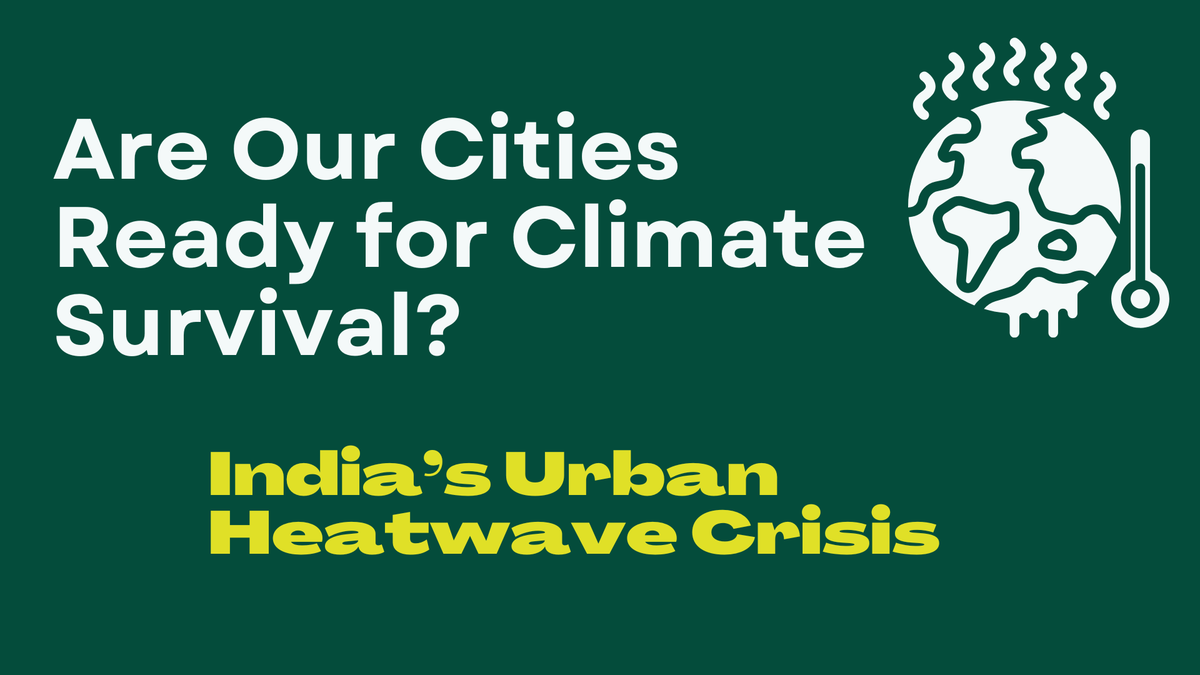India’s Urban Heatwave Crisis: Are Our Cities Ready for Climate Survival?
India faces deadly urban heatwaves in 2025 are our cities prepared for climate survival? A deep dive into rising risks and urgent solutions.

A Crisis Unfolds: India's Scorching Cities
In 2025, India is experiencing an unrelenting heatwave—one that is expanding in geography and intensity. From the early meat of April, cities including Delhi, Mumbai, and Hyderabad have been scorched by record-high temperatures—Delhi repeatedly crossing 40 °C, Rajasthan recording 44 °C, and barometer peaks reaching 46 °C over the northwest. (timesofindia.indiatimes.com)
The India Meteorological Department (IMD) has been issuing consecutive red and orange alerts, signaling perilously high "feels-like" temperatures approaching 50 °C in urban regions
This isn't summer—this is a redline crisis. The crisis highlights what climatologists have been warning: heatwaves are no longer freak events but now a deadly new normal fueled by climate change, urban heat island phenomenon, and compromised pre-monsoon winds .
Urban Hotspots: Most alarming temperatures are expected in Delhi, Mumbai, Hyderabad
Delhi: Weather Crisis Confronts Systemic Failure
Delhi, with a population of more than 16 million, recently experienced multiple days in excess of 40 °C—a climatological deviation of 5 °C above normal. (en.wikipedia.org)
While the Delhi Heat Action Plan 2025 was initiated in April—vowing 3,000 water coolers, shaded shelters, changed working hours, and hospital preparedness implementation has been dismal. Fewer than 20 coolers have been deployed and shelters lie unbuilt. (m.economictimes.com)
The IMD has attempted innovative outreach, deploying color-coded alerts and WhatsApp advisories for informal workers—yet the impact remains uncertain
Meanwhile, urban wildlife and stray animals are dying: over 150 dehydrated birds rescued in a week, and street dogs collapsing in the Sun
Mumbai: Building Resilience or Cementing Heat?
Mumbai’s Climate Action Plan (MCAP) was launched in 2021, envisioning net-zero emissions by 2050 and urban greening
However, quick concretization and green cover loss 40% since 1980—has turned the city into a heat sink; dark roofs and blacktop pavement trap heat while taxing energy systems. (en.wikipedia.org.)
While MCAP encourages green spaces, mangrove recovery, cool roofs, and reflective pavements, few have been implemented. Heat Action Plans are still limited in scope, with long-term adaptation plans slow to implement.
Hyderabad: The Silent Struggle
Hyderabad has been less covered by the media, but a 2013 GIS‑based analysis already pointed to the city's susceptibility as rapid urbanization destroys vegetation and builds up thermal density nghhin.org
Public heat response data in 2025 is scarce—a disturbing lack during record pre-monsoon temperatures, which frequently reach 45 °C.
Root Causes: Hot Infrastructure, Cool Planning?
Urban Heat Islands (UHIs).
Urban surfaces retain and release heat; research indicates Indian megacities range from 1‑6 °C warmer than nearby rural areas nghhin.org
Decline in green cover in cities such as Mumbai, Delhi, and Hyderabad translates into fewer nature-based cooling systems.
Climate‑Driven Heat Trends.
Delhi, Maharashtra, Telangana, and Telangana-tier cities such as Hyderabad are among the most heat-vulnerable states according to the CEEW's district‑level Heat Risk Index (HRI), courtesy of increasing daytime and, more importantly, night time temperatures
Since 2024, warm nights have risen even more than hot days retaining heat and restricting recovery
Legacy Infrastructure & Modern Mistakes.
Colonial-era compact planning and post-1990s Western-style concrete/glass building techniques increase heat absorption.(nature.com)
Vernacular traditional architecture—earthen walls and shaded high-ceilinged verandas has given way. Air conditioning forces waste heat back into the city environment, increasing ambient temperature.
Infrastructure Gaps: Where Cities Fall Short
Public Cooling Facilities
Delhi designed mass water coolers and shaded areas—but most are still on paper. Few suburban mechanical aids (water bowsers) have been installed
Mumbai lacks equivalent large-scale public cooling systems apart from occasional "cool roofs" and occasional greening.
Emergency Health Capacity
Though Delhi has established "heatwave wards" and ICU clusters within hospitals, lack of systematic data-sharing and delayed roll-out weakens effectiveness Hyderabad's emergency health preparedness is uncertain.
Early Warning & Outreach
Community-level warnings (e.g., WhatsApp/WLA posters) have commenced in Delhi. But city-wide, rural-style warning systems for slums and street vendors are patchy too often neglecting the most at-risk. Cooling centers, water stations, and visiting informal workers are still inadequate.
Heat-Resilient Urban Design
Key adaptation measures like greened corridors, porous pavements, reflective roofs, and urban lakes are emphasized in plans (e.g., MCAP) but languid in implementation. Pilot schemes only; scale and upkeep are issues.
The Human Cost: Health, Livelihoods, Risk
- Public health emergency.
Red and orange heat warnings overlap with an increase in heatstroke, heat exhaustion, and cardiovascular strain particularly in older adults, children, and workers outdoors
- Pressure on healthcare systems.
2024‑25 reports show more than 40,000 suspected heatstroke and at least 110 confirmed heat-related fatalities. Hospitals struggle to cope with scarce heat wards and patchy preparedness.
- Informal economy under threat.
Street vendors, construction workers, waste scavengers, and delivery workers are subject to constant exposure. Delhi's labour-oriented alert system is a beginning but even the majority of workers do not have access to shade, water, or shift breaks.
- Urban wildlife in crisis.
More than 150 heat-stressed birds have been saved in a week in Delhi alone, with urban forests and water points being restored. The resilience of ecosystems is unraveling in parallel with human health.
Strategic Outlook: Planning for Survival
To meet the 2025 India heatwave crisis, cities need to shift from reactive to proactive measures. CEEW underscores priority national imperatives: incorporate night-time heat into risk assessments, invest in cool roofs, net-zero shelters, parametric heat insurance, and upscale Heat Action Plans. (timesofindia.indiatimes.com)
Holistic policy structures are needed from a planning point of view:
- Risk-informed zoning. Utilize district-level Heat Risk Indices to target cooling investments in urban hotspots.
- Infrastructure upgrade requirements. Mandate reflective roofs, green facades, permeable walkways, and passive cooling structures in building regulations.
- Scale up nature-based solutions. Prioritize urban trees, parkland increase, street canopies, wetlands, and pond restoration.
- Strengthen community systems. Implement multilingual, visually coded warning systems, water kiosks, shade stations, and adaptive working hours for informal workers.
- Strengthen public health infrastructure. Permanently require heat/ICU wards, real-time case tracking, and training in healthcare facilities.
- Back with finance & enforcement. Link heat planning with disaster relief funds & climate resilience budgets; enact strong municipal governance & accountability.
The Immediacy of 2025
As India embarks on its new era of heat—more frequent early-season heatwaves and broiler nights policy lethargy is not only irresponsible; it's deadly. To quote CEEW: "Heat stress is no longer a future threat it's a present reality". (ghhin.org)
Our cities cannot rely on half-measures or slogans. Delhi’s unimplemented water coolers, Mumbai’s vanishing vegetation, Hyderabad’s invisibilized heat—all signal an urban crisis in desperate need of alignment: science + policy + implementation.
Conclusion: Heat Safety Is Climate Readiness
India heatwave 2025 is a clarion call: without immediate, concerted adaptation and readiness urban climate planning is mere rhetoric.
If we do not change, millions will pay the price: with heatstroke fatalities, failing ecosystems, and economic disarray. But if we act boldly and immediately we can redesign our cities as climate‑resilient, heat‑prepared communities.
Will we rise to the challenge? Or will we be overwhelmed by our own concrete jungles, smoldering under a relentless sun?
Check out Allegedly News Network to stay up-to-date, participate in our Heat Safety Campaign, and call for climate-resilient cities. Your voice can make a difference because in 2025, survival is more than policy. It's our mission.




